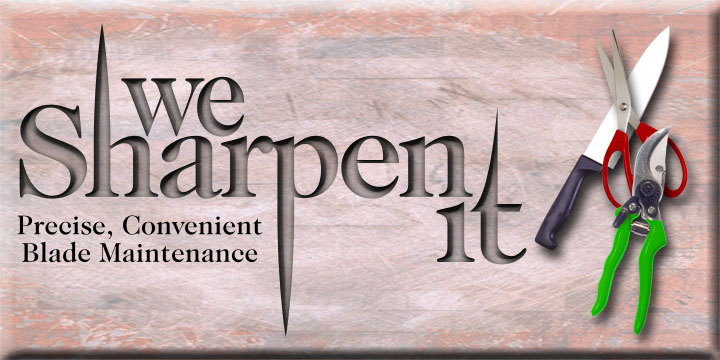
| Home | Schedule | Prices | ---- | Editorials (about -->) | Knives | Scissors | Lawnmowers | Garden Tools | Quality Knives |

How Do You Tell If Your Knife Is Sharp?
|
Sharpening devices. A good quick and safe test for sharpness is just to hold the edge up to the light and look straight down onto it. If it can reflect light back to you, it is dull. Any bright spots are nicks and/or dings. I have found this a very useful rule to show people exactly what went wrong with their knives. This rule does ignore one very important variable however, and that is the correct cutting angle. A knife can appear and even feel (God forbid) sharp, but just not cut as it should. This is very common, especially in cases where the knife has been repeatedly touched up freehand on a steel. The problem is, the cutting angle is no longer an angle, but is rounded off to a radius of some sort due to the fact that the angle is not held consistantly freehand. You are bound to "wiggle" unless you are taking steps to prevent the wiggle. Your knife will be no sharper than your biggest wiggle! Over time, everyone tends to loose it. Even professional chef's want their knives trued once in a while. A "shaving sharp" edge is a little difficult to obtain with most sharpeners. (Please don't try this kind of test)! Any burr means that the knife is not ever going to be sharper than the burr is thick. Many of the hand held sharpening devices sold, only partially do the job, and often not for long. People ask me what kind of sharpener I recommend, and I have to say "none of them! That is why there are so many different ideas on the market! None of them work consistantly and reliably". A really good machine is going to cost over a hundred bucks. The steel is probably the best,cheapest,and simplest device among the more practical, but you have to learn how to hold that angle consistantly over a period of time, plus you have to avoid oversharpening by touching up too often. If you follow correct knife care procedures, namely rinse the knife immediately after use, and put it back in the block, and only cut on a cutting board or proper surface for the purpose, they won't be getting dull. Most knives are dulled by hitting other things, and/or cutting into a hard surface such as a plate. Cutting food does not dull knives. Dishwasher machines are a huge no-no. Everything rattles around in there and in effect shotpeens the cutting edge all to heck. The hot water and heat destroys many types of handles. Don't use a grinder. Knives should not be sharpened on a grinder, as the high speed and resulting heat will alter the micro edge, by invisibly drawing back the hardness to some degree. The very best knives are made of stainless steel alloys and raised to an extra level of hardness by following the quench with a dip into liquid nitrogen or something similar. This takes the temperature down to near minus 200 degrees F. , a process known as cyrogenic heattreating or Ice Hardening. The metal is then lightly drawn (tempered) to stress relieve a bit and hopefully take the edge off of the brittleness problem. The better the grade of knife, the more likely it is to chip. This really surprises most people. Pry apart frozen steaks, and the knife is likely to shatter or crack. Houses with teenagers, simply should not have the really good knives! A cheaper knife will bend and beat up perhaps, but be salvageable! Save money. You can save yourself a lot of money by purchasing knives carefully at garage sales and by obtaining local advice about special price offerings in your area. Brand names do not mean much these days as some of most well known and expensive lines also will have a "consumer" line under their brand name, that may be disappointing. A few weeks ago I found a deal at a local chain store, that had an 8 inch Santuku knife and a 4 1/2 paring knife for $17 dollars for the set. These turned out to be perfectly good "made in China" knives. Off-shore production does not necessarily have to be bad, if the goods are via a company that pays attention to what they are buying and if they do their managment homework with the producer. Buying a boatload of goods based on a sample at a tradeshow in Shanghai does not do it, anymore that using a wideopen specification range for the hardness and materiel. These conditions are all too common in the rush for cheap ("value engineered"), and high profit. How often? Your good knives should not need professional sharpening more often than perhaps every six months, and with good care at home, more like once a year-and this on general principles more than anything else. Your professional sharpener should be able to diagnose your knifes and give you some hints and instruction fitted to your requirements. There is no extra charge for this in my case, and with most sharpeners that I know. Professional sharpening and truing up is a very good value.
|
Click Here For Editorials List
Walt and Eileen Galer
360-756-6044